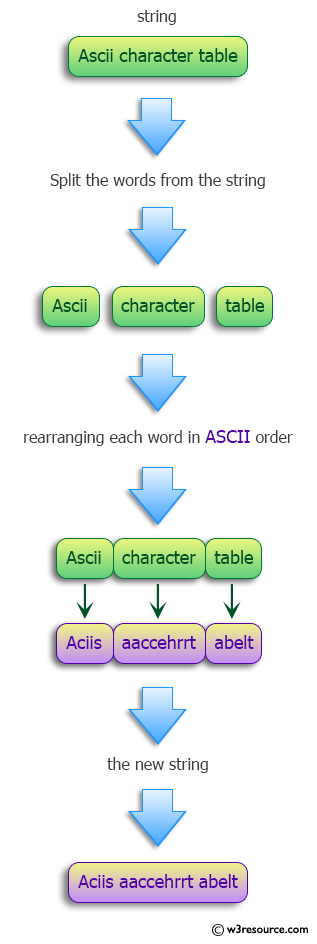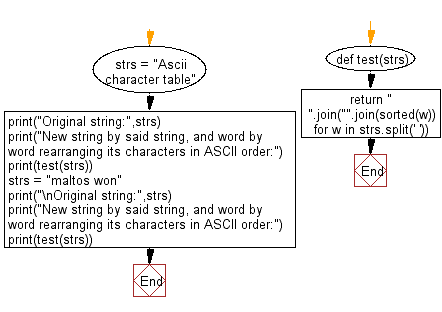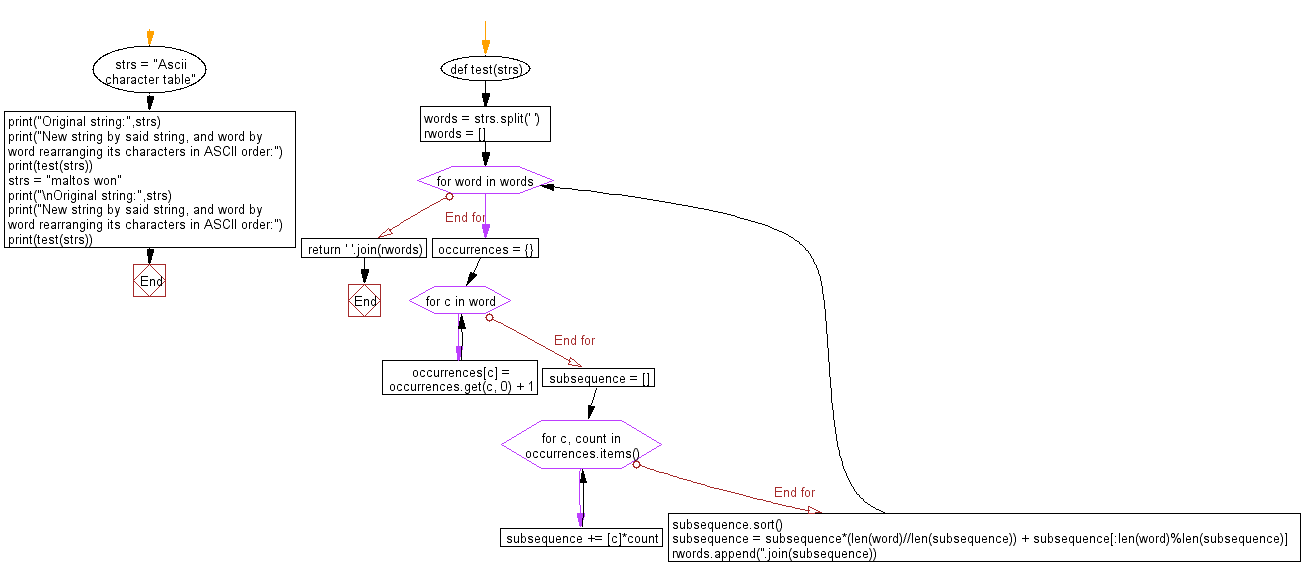Python: Create a new string by taking a string, and word by word rearranging its characters in ASCII order
Python Programming Puzzles: Exercise-69 with Solution
Write a Python program to create a new string by taking a string, and word by word rearranging its characters in ASCII order.
Input: Ascii character table Output: Aciis aaccehrrt abelt Input: maltos won Output: almost now
Pictorial Presentation:

Sample Solution-1:
Python Code:
#License: https://bit.ly/3oLErEI
def test(strs):
return " ".join("".join(sorted(w)) for w in strs.split(' '))
strs = "Ascii character table"
print("Original string:",strs)
print("New string by said string, and word by word rearranging its characters in ASCII order:")
print(test(strs))
strs = "maltos won"
print("\nOriginal string:",strs)
print("New string by said string, and word by word rearranging its characters in ASCII order:")
print(test(strs))
Sample Output:
Original string: Ascii character table New string by said string, and word by word rearranging its characters in ASCII order: Aciis aaccehrrt abelt Original string: maltos won New string by said string, and word by word rearranging its characters in ASCII order: almost now
Flowchart:

Visualize Python code execution:
The following tool visualize what the computer is doing step-by-step as it executes the said program:
Sample Solution-2:
Python Code:
#License: https://bit.ly/3oLErEI
def test(strs):
words = strs.split(' ')
rwords = []
for word in words:
occurrences = {}
for c in word:
occurrences[c] = occurrences.get(c, 0) + 1
subsequence = []
for c, count in occurrences.items():
subsequence += [c]*count
subsequence.sort()
subsequence = subsequence*(len(word)//len(subsequence)) + subsequence[:len(word)%len(subsequence)]
rwords.append(''.join(subsequence))
return ' '.join(rwords)
strs = "Ascii character table"
print("Original string:",strs)
print("New string by said string, and word by word rearranging its characters in ASCII order:")
print(test(strs))
strs = "maltos won"
print("\nOriginal string:",strs)
print("New string by said string, and word by word rearranging its characters in ASCII order:")
print(test(strs))
Sample Output:
Original string: Ascii character table New string by said string, and word by word rearranging its characters in ASCII order: Aciis aaccehrrt abelt Original string: maltos won New string by said string, and word by word rearranging its characters in ASCII order: almost now
Flowchart:

Visualize Python code execution:
The following tool visualize what the computer is doing step-by-step as it executes the said program:
Python Code Editor :
Have another way to solve this solution? Contribute your code (and comments) through Disqus.
Previous: Find all 5's in integers less than n that are divisible by 9 or 15.
Next: Find the first negative balance.
What is the difficulty level of this exercise?
Test your Programming skills with w3resource's quiz.
Python: Tips of the Day
Find current directory and file's directory:
To get the full path to the directory a Python file is contained in, write this in that file:
import os dir_path = os.path.dirname(os.path.realpath(__file__))
(Note that the incantation above won't work if you've already used os.chdir() to change your current working directory, since the value of the __file__ constant is relative to the current working directory and is not changed by an os.chdir() call.)
To get the current working directory use
import os cwd = os.getcwd()
Documentation references for the modules, constants and functions used above:
- The os and os.path modules.
- The __file__ constant
- os.path.realpath(path) (returns "the canonical path of the specified filename, eliminating any symbolic links encountered in the path")
- os.path.dirname(path) (returns "the directory name of pathname path")
- os.getcwd() (returns "a string representing the current working directory")
- os.chdir(path) ("change the current working directory to path")
Ref: https://bit.ly/3fy0R6m
- New Content published on w3resource:
- HTML-CSS Practical: Exercises, Practice, Solution
- Java Regular Expression: Exercises, Practice, Solution
- Scala Programming Exercises, Practice, Solution
- Python Itertools exercises
- Python Numpy exercises
- Python GeoPy Package exercises
- Python Pandas exercises
- Python nltk exercises
- Python BeautifulSoup exercises
- Form Template
- Composer - PHP Package Manager
- PHPUnit - PHP Testing
- Laravel - PHP Framework
- Angular - JavaScript Framework
- Vue - JavaScript Framework
- Jest - JavaScript Testing Framework
